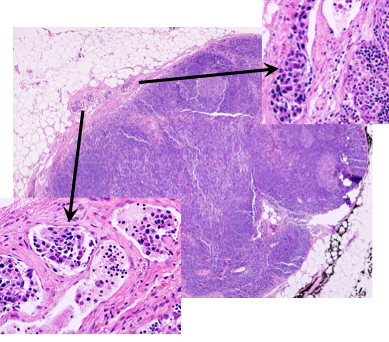Correct! Lymphedema is an accumulation of interstitial fluid in the affected region.
How would a complete axillary node dissection (CAD) lead to lymphedema?
You alleviate your patient’s unease by explaining that the margins of her positive lymph nodes were free of disease after the SNL biopsy and a CAD is not necessary. As an additional measure, you advise for a bone and liver scan. Luckily no additional metastasis was seen.
From the original histology slide, what vessels were infiltrated with tumor cells?

Your eventual diagnosis is infiltrating ductal carcinoma with micrometastasis. Based on the case presented, select your patient’s stage of breast cancer.
| Staging of Breast Cancer | ||
|---|---|---|
| Stage | Circumstances | 5-yr Survival |
| Stage 0 | Duct cell or lobular in situ | 92% |
| Stage I | Invasive carcinoma, <2 cm No metastasis |
87% |
| Stage II | Invasive carcinoma, <5 cm Involved axillary nodes No distant metastasis |
75% |
| Stage III | Invasive cancer >5cm, with nodal involvement Any cancer with ipsilateral internal mammary node involvement Any cancer with chest wall fixation, skin or pectoral involvement, inflammatory carcinoma No distant metastasis |
46% |
| Stage IV | Any cancer with distant metastasis (including ipsilateral supraclavicular lymph nodes) | 13% |